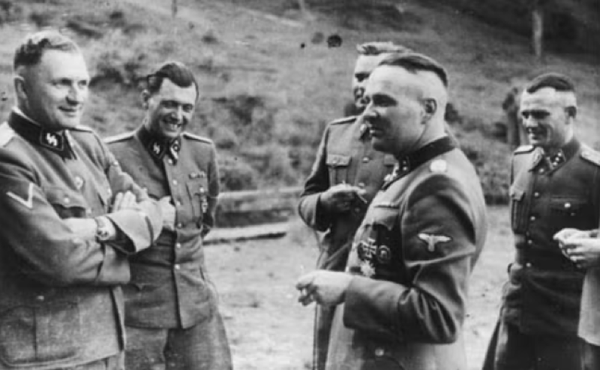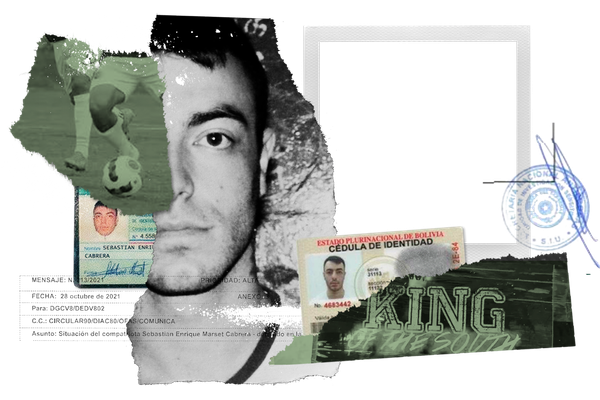Sometimes sending data by pigeon beats the internet
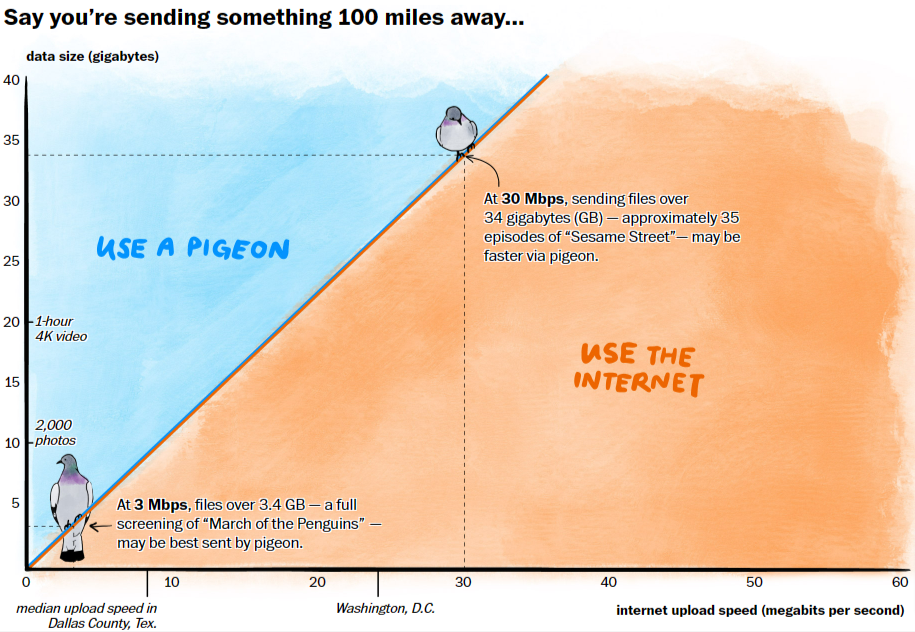
From Janice Kai Chen for the Washington Post: "Internet speeds have come a long way since the days of the dial-up modem, but sometimes you can’t beat the millennia-old method of carrier pigeon. Ancient Greeks used the so-called rats of the sky to spread results of the Olympic Games. In 1850, Reuters used a fleet of 45 pigeons to send news and stock prices 75 miles between Brussels and Aachen, Germany. The trip took two hours. (A train would have taken six.) Whether a pigeon can best the internet depends on three things: internet speed (check your own here), distance and data. It doesn’t make a difference online whether you’re sending a file across town or across the country. It’s the size of data that slows the internet down. The longer the journey, the bigger the data needs to be for the bird to out-fly broadband." (Related: Jona on Mastodon pointed me towards a network standard proposed in 1990 for the transmission of data by pigeon, and Amazon offers large customers a service they call Snowmobile, which puts hundreds of petabytes of data on a truck)
How a 30-year-old cassette tape became a sudden musical sensation
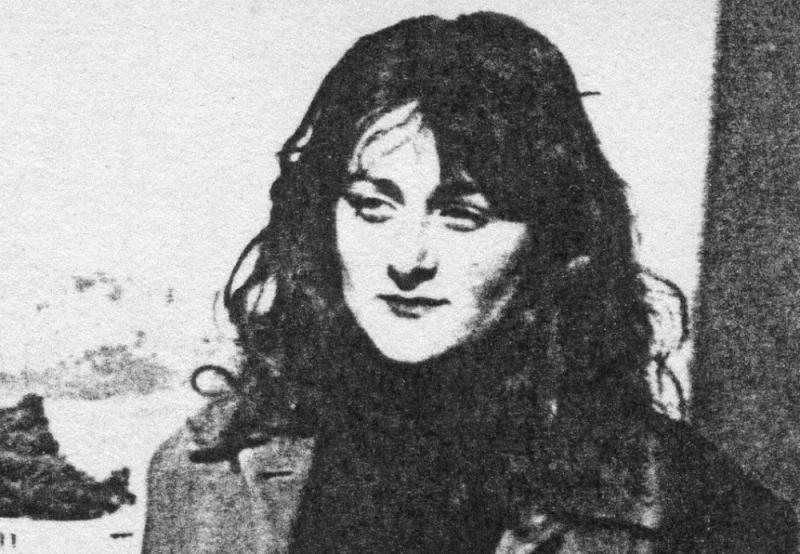
From Kieron Tyler for The Arts Desk: "Moments into “Maker of me”, it’s evident that The Story of Valerie is special. A circular piano figure accompanies a disembodied female voice singing and speaking of a relationship that’s “greater than myself.” The album was recorded in 1990 and until 2018 had been heard by barely anyone. In 1987, the British-born Carola Baer was in San Francisco intending to stop-off there for a few days on her way from England to Australia. She stayed until 2007. The album contains solo recordings she circulated on cassette tapes in the hope of finding like-minded musicians. One of the cassettes was found in a Portland, Oregon charity shop last year and this discovery has led to The Story of Valerie being issued as a legitimate recording."
Netflix blew $55 million on a science-fiction epic that will never be seen

From John Carreyrou for the New York Times: "A little-known filmmaker named Carl Erik Rinsch had directed only one movie, “47 Ronin.” It was a commercial and critical dud, and Mr. Rinsch’s tussles with its producers had raised eyebrows, even in an industry where such conflicts are the norm. But memories in Hollywood are short, and the demand for new content was intense. Amid the feeding frenzy, the project that Mr. Rinsch was pitching, a science-fiction series about artificial humans, became a hot property. After a competitive auction, Mr. Rinsch and his team reached an informal eight-figure agreement with Amazon. But before they had a chance to put it in writing, Netflix swooped in. Netflix won the deal — and would soon come to regret it."
Editor's note: If you like this newsletter, I'd be honoured if you would help me by contributing whatever you can via my Patreon. Thanks!
Fluorescent mammals are a lot more common than you might think

From The Conversation: "Recently, several mammals have been reported to glow under ultraviolet light, including the platypus. But no one knew how common it was among mammals until now. Research published recently found this glow, known as fluorescence, is extremely common. Almost every mammal studied showed some form of fluorescence. The phenomenon is quite common among birds, reptiles, and amphibians, but has been described less frequently in mammals. Some rodents have a pink glow under UV light and platypuses glow blue-green. Researchers found clear evidence of fluorescence in the white fur, spines and even skin and nails of koalas, Tasmanian devils, echidnas, hairy-nosed wombats, bandicoots, greater bilbies and even cats."
The high-flying life of pioneering Native American aviator Mary Riddle
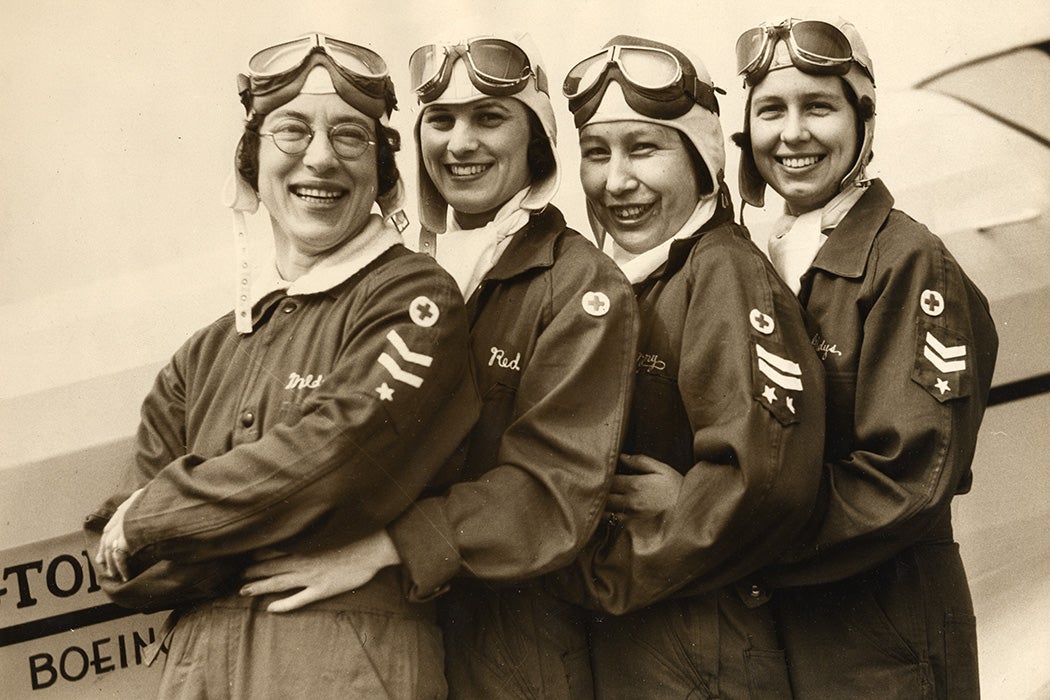
From Ashawnta Jackson for JSTOR Daily: "Mary Riddle was a daredevil. Whether it involved cars, motorcycles, swimming, or travel, she had a thirst for adventure. But it was her love of flying that put her in the history books. Born Nannie Riddell in Willapa Bay, Washington, in 1920, the woman who’d come to be known as Mary Riddle was one of the earliest Native American women aviators. Flying under the name “Princess Kus-de-cha,” Riddle walked a line, as did many people of color. by the 1930s, when Riddle took flight, there were many women aviators – enough that in 1929 they staged the first National Women’s Air Derby. But Riddle bore the dual oppressions of race and gender, making her achievements even more extraordinary."
How R2D2 ended up in Jesus of Nazareth

From Paul Cole for Birmingham Live: "Stars Wars android R2D2, the much-loved robot made famous by Birmingham actor Kenny Baker, was involved in a blunder of Biblical proportions. During filming of the original Star Wars movie in Tunisia, Artoo careered out of control. He sped off the set being used to film desert scenes of Luke Skywalker’s home planet, Tattooine, and ended up right in the middle of a nearby set that was being used by director Franco Zeffirelli to film his epic Jesus of Nazareth TV series, starring Robert Powell. Shooting in the desert was a nightmare for Baker and the rest of the cast, according to a new book. Director George Lucas admitted there were repeated problems with the robots, which often didn’t work properly."
How can-openers have evolved over the past two hundred years

Acknowledgements: I find a lot of these links myself, through RSS feeds etc. But I also get some from other newsletters and blogs that I rely on as "serendipty engines." They include Today In Tabs, Clive Thompson's Linkfest, Maria Popova's website The Marginalian, The Morning News from Rosecrans Baldwin and Andrew Womack, Why Is This Interesting, Dan Lewis's Now I Know, Robert Cottrell and Caroline Crampton's The Browser, Sheehan Quirke AKA The Cultural Tutor, the Smithsonian magazine, and JSTOR Daily. If you come across something you think should be included here, feel free to email me.
